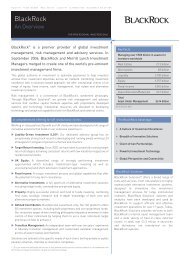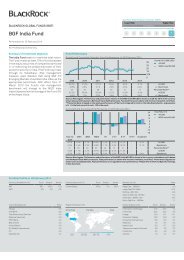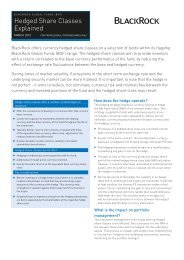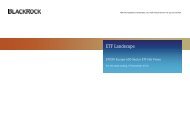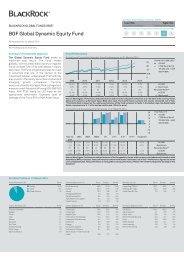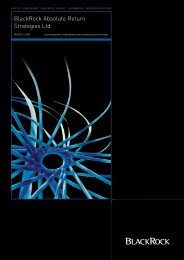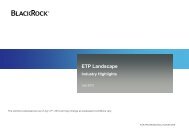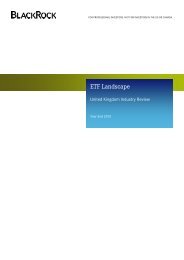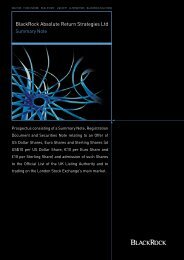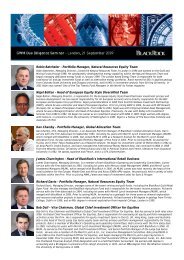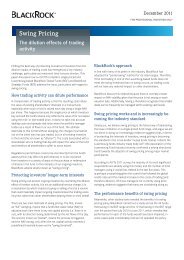ETF Landscape: Celebrating 10 Years of ETFs in Europe - BlackRock
ETF Landscape: Celebrating 10 Years of ETFs in Europe - BlackRock
ETF Landscape: Celebrating 10 Years of ETFs in Europe - BlackRock
- No tags were found...
Create successful ePaper yourself
Turn your PDF publications into a flip-book with our unique Google optimized e-Paper software.
<strong>ETF</strong> <strong>Landscape</strong> April 20<strong>10</strong><strong>Celebrat<strong>in</strong>g</strong> <strong>10</strong> <strong>Years</strong> <strong>of</strong> <strong>ETF</strong>s <strong>in</strong> <strong>Europe</strong> from <strong>BlackRock</strong>Investment concerns<strong>ETF</strong>s possess risks related to the securities <strong>in</strong> their underly<strong>in</strong>g<strong>in</strong>dices. <strong>ETF</strong>s are subject to risks applicable to any <strong>in</strong>vestment <strong>in</strong>portfolios <strong>of</strong> common stocks or bonds, <strong>in</strong>clud<strong>in</strong>g that <strong>of</strong> generallylower prices and the chance that they may underperform moreconcentrated or actively managed portfolios. By target<strong>in</strong>gperformance <strong>in</strong> l<strong>in</strong>e with <strong>in</strong>dices, <strong>in</strong>vestors are also forego<strong>in</strong>gopportunities to outperform.<strong>ETF</strong>s are subject to ‘track<strong>in</strong>g error’ risks. Factors such asexpenses, imperfect correlation between an <strong>ETF</strong>’s stocks andthose <strong>in</strong> its underly<strong>in</strong>g <strong>in</strong>dex and regulatory policies may causean <strong>ETF</strong>’s return to deviate from its underly<strong>in</strong>g <strong>in</strong>dex. Six majorsources <strong>of</strong> track<strong>in</strong>g error are summarised below: Fees and expenses: expenses <strong>of</strong> all fund products reducetotal return. Although <strong>ETF</strong>s have the low expense ratios, feeswill cause an <strong>ETF</strong> to underperform its <strong>in</strong>dex over time. Premiums/discounts: on any date, the clos<strong>in</strong>g price <strong>of</strong> an<strong>ETF</strong> may be at a premium or discount to its Net Asset Value(NAV) due to supply and demand factors. This will affectreported performance <strong>of</strong> the <strong>ETF</strong> versus its <strong>in</strong>dex. Dividend re<strong>in</strong>vestment: some <strong>ETF</strong>s hold dividends <strong>in</strong> cashand only pay them out to <strong>in</strong>vestors on a periodic basis. Incontrast, some <strong>ETF</strong>s can re<strong>in</strong>vest dividends daily. A lag <strong>in</strong>dividend re<strong>in</strong>vestment can cause small underperformance <strong>in</strong>ris<strong>in</strong>g markets. Optimised replication: many <strong>ETF</strong>s use computeroptimisation techniques to design portfolios to closely trackthe <strong>in</strong>dex while m<strong>in</strong>imis<strong>in</strong>g transaction costs. Under thistechnique, the <strong>ETF</strong> omits or underweights some stocks (usuallythe less liquid or smaller-cap stocks). This technique, ifproperly used, should have only a m<strong>in</strong>or effect on track<strong>in</strong>g. Rebalanc<strong>in</strong>g: <strong>ETF</strong>s are required to make changes <strong>in</strong> thecomposition <strong>of</strong> their portfolios when stocks are added to ordropped from the <strong>in</strong>dex. The tim<strong>in</strong>g, market impact, andtransaction costs <strong>of</strong> the changes can affect performance. Nonconcurrent trad<strong>in</strong>g hours: some <strong>ETF</strong>s trade <strong>in</strong> theUnited States when their underly<strong>in</strong>g markets are closed. Forexample, the Japanese market is closed while an <strong>ETF</strong> track<strong>in</strong>gthe Japanese market is trad<strong>in</strong>g on NYSE Arca. Given <strong>in</strong>creasedcorrelation between markets, <strong>ETF</strong>s based on the Japanesemarket may appear to be at a premium prior to the start <strong>of</strong> thetrad<strong>in</strong>g day <strong>in</strong> Japan when the United States’ market is up <strong>in</strong>anticipation that the Japanese market will rally. Similarly, on adown day <strong>in</strong> the United States, the <strong>ETF</strong>s on the Japanesemarket may appear to trade at a discount.Many <strong>Europe</strong>an <strong>in</strong>vestors prefer <strong>ETF</strong>s that are UCITS funds froma regulatory and dividend withhold<strong>in</strong>g po<strong>in</strong>t <strong>of</strong> view. Some<strong>Europe</strong>an <strong>in</strong>vestors are only allowed to <strong>in</strong>vest <strong>in</strong> UCITS funds. For<strong>Europe</strong>an and Asian <strong>in</strong>vestors, dividend withhold<strong>in</strong>g may behigher when <strong>in</strong>vest<strong>in</strong>g <strong>in</strong> US listed <strong>ETF</strong>s as they may sufferdividend withhold<strong>in</strong>g with<strong>in</strong> the <strong>ETF</strong>s as well as on dividends paidout <strong>of</strong> the <strong>ETF</strong>.Basic <strong>ETF</strong> structures<strong>ETF</strong>s have dist<strong>in</strong>ctive features. Each <strong>ETF</strong> is designed to track aspecific <strong>in</strong>dex. They provide access to <strong>in</strong>vestment styles, assetclasses, markets, and different sectors. They are structured asopen-end funds which are domiciled and registered <strong>in</strong> manycountries around the world. The assets <strong>of</strong> <strong>ETF</strong>s are held bycustodians <strong>in</strong> a r<strong>in</strong>g fenced structure.Most <strong>ETF</strong>s purchase the underly<strong>in</strong>g securities <strong>in</strong> the <strong>in</strong>dex withthe majority fully replicat<strong>in</strong>g their underly<strong>in</strong>g <strong>in</strong>dex, many havethe capacity to employ optimisation and sampl<strong>in</strong>g techniques.These <strong>ETF</strong>s may exclude certa<strong>in</strong> securities and deviate from theirbenchmark constituent weights, which could lead totrack<strong>in</strong>g error.The open-end structure typically allows funds to lend stock,which may generate extra <strong>in</strong>come. In addition, these funds canhold other securities and f<strong>in</strong>ancial <strong>in</strong>struments, <strong>in</strong>clud<strong>in</strong>g cashand equivalents and futures. Dividends are typically paid outquarterly, semi-annually or annually, although some <strong>ETF</strong>s dore<strong>in</strong>vest dividends <strong>in</strong> the fund.In <strong>Europe</strong>, a new approach is be<strong>in</strong>g used to create funds and<strong>ETF</strong>s which utilise a total return swap plus a basket <strong>of</strong> securitiesto comply with the diversification rules under Undertak<strong>in</strong>gs forCollective Investments <strong>in</strong> Transferable Securities (UCITS III) todeliver <strong>in</strong>dex performance rather than purchas<strong>in</strong>g the underly<strong>in</strong>gsecurities <strong>in</strong> the <strong>in</strong>dex.Investors who are express<strong>in</strong>g concerns over counterparty risk,transparency and liquidity when us<strong>in</strong>g structured products,swaps, certificates, and notes are show<strong>in</strong>g a preference for <strong>ETF</strong>swhere the structure is a fund, and <strong>of</strong>ten, more specifically for<strong>ETF</strong>s which purchase the underly<strong>in</strong>g securities <strong>in</strong> the <strong>in</strong>dex.<strong>ETF</strong>s tend to trade at or close to the NAV <strong>of</strong> the underly<strong>in</strong>gbasket <strong>of</strong> shares. Arbitrageurs would take advantage <strong>of</strong>significant premium or discount relative to the underly<strong>in</strong>g <strong>in</strong>dex.An arbitrageur would typically buy or sell the <strong>ETF</strong> and place an<strong>of</strong>fsett<strong>in</strong>g buy or sell transaction <strong>in</strong> the underly<strong>in</strong>g basket <strong>of</strong>component stocks or futures.<strong>ETF</strong> providers have cont<strong>in</strong>ued to expand their product ranges <strong>in</strong>more specialised areas to cater for the grow<strong>in</strong>g number <strong>of</strong>pr<strong>of</strong>essional and retail <strong>in</strong>vestors us<strong>in</strong>g <strong>ETF</strong>s as advanced portfolioconstruction tools.The <strong>in</strong>creas<strong>in</strong>g availability <strong>of</strong> these highly-specialised <strong>ETF</strong>s acrossthe full spectrum <strong>of</strong> equities, fixed-<strong>in</strong>come and alternative<strong>in</strong>vestments now ensures that <strong>in</strong>vestors can use <strong>ETF</strong>s to <strong>in</strong>stantlyreallocate capital to take advantage <strong>of</strong> new <strong>in</strong>vestmentopportunities as market conditions stabilise.44 This document is not an <strong>of</strong>fer to buy or sell any security or to participate <strong>in</strong> any trad<strong>in</strong>g strategy. Please refer to important <strong>in</strong>formation and qualifications at the end <strong>of</strong> this material.



